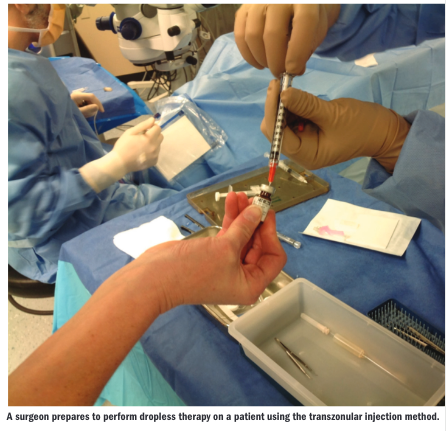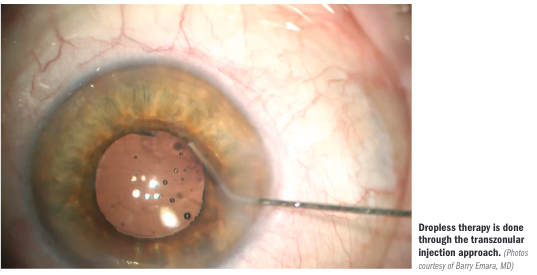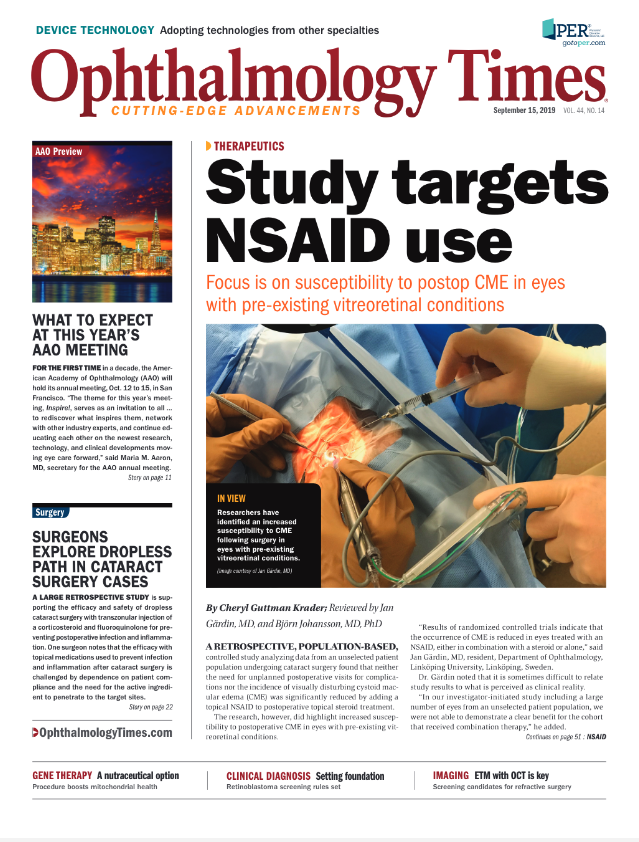Publication
Article
Digital Edition
Surgeons explore dropless for cataract surgery
Author(s):

This article was reviewed by Barry Emara, MD
Findings from a large retrospective study support the efficacy and safety of dropless cataract surgery with transzonular injection of a corticosteroid and fluoroquinolone (Tri-Moxi, Imprimis Pharmaceuticals) for preventing postoperative infection and inflammation, according to Barry Emara, MD.
Aiming to characterize outcomes from his first 1,000 patients, Dr. Emara reviewed outcomes in 1,166 eyes that received a 0.2 mL transzonular injection of triamcinolone acetonide and moxifloxacin hydrochloride at conclusion of cataract surgery. The series included all patients who underwent dropless cataract surgery between February 2016, when he first began using the technique, through September 2018.

Dr. Emara noted that postoperative treatment with a topical corticosteroid was needed by 106 eyes (9.1%), and there were no cases of endophthalmitis. The need for a topical corticosteroid was similar in an updated series that included an additional 221 eyes. In the expanded population, 118 (8.6%) of 1387 eyes required topical corticosteroid treatment, and there were no cases of endophthalmitis.
Related: Safety key for intracamerally injected mydriatic agents in cataract surgery
“Efficacy with topical medications used to prevent infection and inflammation after cataract surgery is challenged by dependence on patient compliance and the need for the active ingredient to penetrate to the target sites,” said Dr. Emara, adjunct professor of ophthalmology, Schulich School of Medicine and Dentistry, Western University, Windsor, Canada. He also operates his private surgical practice out of the Windsor Surgical Centre.
“Challenges often lead to innovation, and the compounded injectable triamcinolone-moxifloxacin formulation address the need for alternatives to topical medications,” he said.
The study population included 884 eyes of 501 patients who underwent bilateral (383 patients) or unilateral (118 patients) conventional cataract surgery and 282 eyes of 165 patients who had bilateral (117 patients) or unilateral (48 patients) femtosecond laser-assisted cataract surgery (FLACS). A topical steroid was added after surgery when patients presented with symptomatic inflammation.
Dr. Emara noted that additional steroid drops were needed for 72 eyes (8.1%) that had conventional cataract surgery and 34 eyes (11.9%) that had FLACS. In his updated series, additional steroid drops were needed for 82 (7.7%) of 1058 eyes that had conventional cataract surgery and 36 (12.6%) of 329 FLACS cases.
Related: Pearls to manage cataract surgery on hypotonous eyes
“From the data it appears that eyes undergoing FLACS are more prone to inflammation than those having conventional cataract surgery,” Dr. Emara said. “Based on this information, surgeons might consider pretreating FLACS patients with a topical NSAID or steroid and possibly using a topical NSAID postoperatively to reduce the susceptibility to inflammation.”
Dr. Emara noted that more than 1 million eyes have undergone dropless cataract surgery in the United States during the past six years, and he cited data reported by other surgeons supporting its efficacy and safety.
Dr. Emara said that placement of the anti-inflammatory and antibiotic medications in the vitreous is preferred over intracameral administration because residence time will be longer in the vitreous and because the vitreous is the site where endophthalmitis establishes itself.
Intravitreal delivery during cataract surgery can be accomplished by either transzonular injection using a cannula or pars plana delivery with a needle. Dr. Emara said he prefers the transzonular route in which the injection is done after IOL implantation because of its convenience and because it maximizes workflow efficiency.
Read more by Cheryl Guttman Krader
Newsletter
Don’t miss out—get Ophthalmology Times updates on the latest clinical advancements and expert interviews, straight to your inbox.






